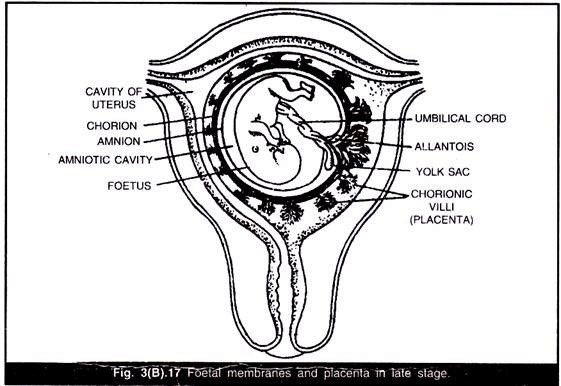Placenta: Structure and Functions - Class 12 PDF Download
Explain placenta with suitable diagram ?
Ref: https://edurev.in/question/650543/Explain-placenta-with-suitable-diagram-
Placenta: Structure and Functions (Explained with Diagram)
Placenta is a structure that establishes firm connection between the foetus and the mother.
From the outer surface of the chorion a number of finger like projections known as chorionic villi grow into the tissue of the uterus. These villi penetrate the tissue of the uterine wall of the mother and form placenta.

The placenta is a connection between foetal membrane and the inner uterine wall. Thus, placenta is partly maternal and partly embryonic. By means of placenta the developing embryo obtains nutrients and oxygen from the mother and gives off carbon dioxide and nitrogenous waste.
In the placenta, the foetal blood comes very close to the maternal blood, and this permits the exchange of materials between the two. Food (glucose, amino acids, lipids), water, mineral salts, vitamins, hormones, antibodies and oxygen pass from the maternal blood into the foetal blood, and foetal metabolic wastes, such as carbon dioxide, urea and warn pass into the maternal blood.
The placenta, thus, serves as the nutritive, respiratory and excretory organ of the foetus. The blood of the mother and foetus do not mix at all in the placenta or at any other place. The blood of the foetus in the capillaries of the chorionic villi comes in close contact with the mother’s blood in the tissue between the villi, Inn they are always separated by a membrane, through which substances must diffuse or lie transported by some active, energy requiring process.
The type of placenta in man is of described as deciduate (intimate contact between loetal and maternal tissue), discoidal (villi occur in the form of disc), haemo-chorial (chorionic epithelium in direct contact with maternal blood).
Functions of Placenta:
The placenta performs the following functions:
1. Nutrition:
Food materials pass from the mother’s blood into the foetal blood through the placenta.
2. Digestion:
The trophoblast ol the placenta digest protein before passing them into foetal blood.
3. Respiration:
Through the placenta oxygen passes from the maternal blood to the foetal blood, and carbon dioxide passes from foetal blood to maternal blood.
4. Excretion:
Nitrogenous wastes such as urea pass from foetal blood into maternal blood through placenta and are filtered out by the kidneys of the mother.
ADVERTISEMENTS:
5. Storage:
The placenta stores glycogen, fat etc. for the foetus before liver is formed.
6. Barrier:
Placenta functions as an efficient barrier (defensive wall) and allows useful: aerials to pass into the Social blood. Harmful substances such as nicotine from cigarette and addictive drugs such as heroin can pass through placenta. Therefore, pregnant women should avoid cigarette and drugs. Viruses and bacteria can pass through placenta.
7. Endocrine function:
Placenta functions as an endocrine gland it secretes hormones such as oestrogen, progesterone and human chorionic gonadotropin (HCG).
Parturition (Birth):
The gestation period or the baby carrying period is the time from conception to birth. In human being, it is approximately 280 days. After a complete period of gestation the child birth takes place. It is called as parturition. Before child birth, there is a long series of involuntary contractions of uterus called as “labour pains”. Umblical cord is a tube containing blood vessels which connect the abdomen of the developing embryo with the placenta of the mother. Its position in the baby is shown by navel.
The signals for parturition orginate from the fully developed foetus and the placenta which induce mild uterine contractions called foetal ejection reflex. Parturition is induced by a complex neuroendocrine mechanism. When time comes for the baby to be delivered, pituitary gland secretes adrenocortico tropic hormone (ACTH) which stimulates the adrenal glands to secrete steroids.
These steroid hormones stimulate placenta to produce Prostaglandins. Hormone oxytocin is secreted from pituitary. These two hormones cause uterus to begin powerful muscular contractions which becomes stronger and stronger over a period of 2 to 18 hours. During that time, the cervix becomes fully dilated and amniotic sac ruptures.
The baby is expelled out of the uterus through the birth canal. Soon after, the placenta is also expelled out of the uterus. Labour pain can be induced artificially by injection of oxytocin or insertion of prostaglandin into the vagina. When the woman is incapable of taking the labour pain, she can have a surgical procedure for child birth called caesarean.
Lactation:
The production and release of milk is called lactation (L. lactare = to suckle). Prolactin, a hormone of anterior pituitary stimulates lactation after parturition. High levels of estrogen act directly on mammary glands and can block the stimulation by prolactin. The mother produces thick, yellowish, high protein fluid called colostrum for 2-3 days after parturition.
Colostrum contains a great amount of maternal antibodies and helps in strengthening the baby’s immune system. Colostrum also acts as a laxative, removing foetal wastes, called meconium, retained in the intestine. The newborn’s suckling stimulates the pituitary to release oxytocin as well as prolactin. Oxytocin triggers milk release from the mammary glands. Breast feeding during the period of infant growth is always recommended for bringing up a healthy baby.

|
Explore Courses for Class 12 exam
|

|
















